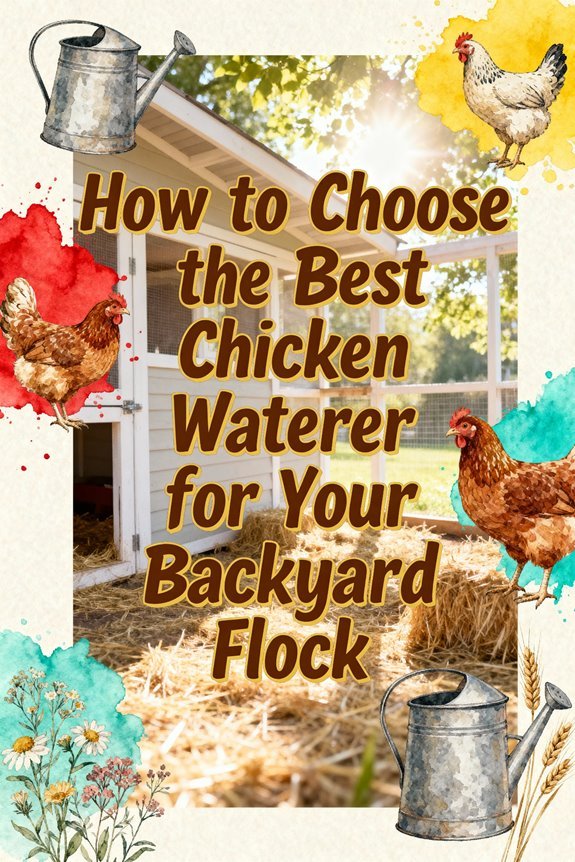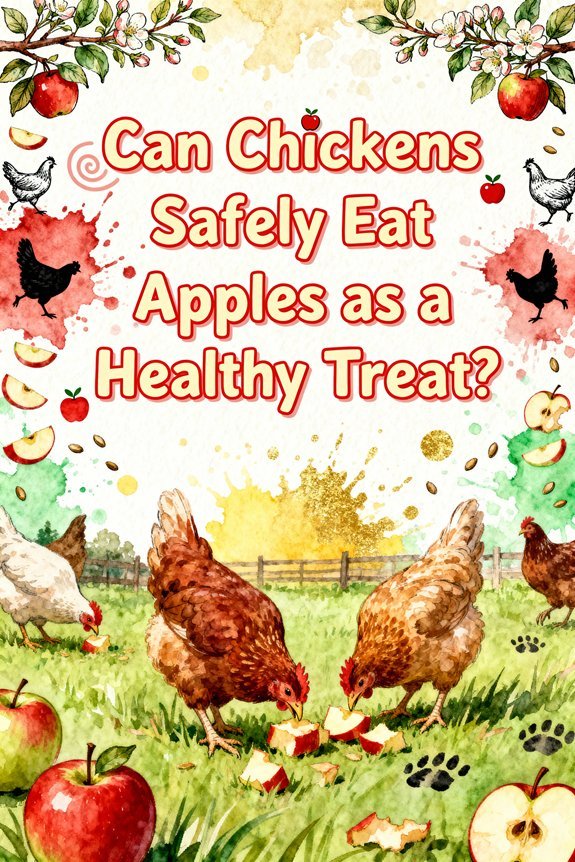Using Tylan 50 in Backyard Chickens: A Complete Guide
Tylan 50, a prescription antibiotic containing tylosin tartrate, treats respiratory infections in backyard chickens through intramuscular or subcutaneous injection. You’ll need to dose based on your bird’s weight: 1/4 ml for bantams, 1/2 ml for birds under 5 lbs, and 1 ml for those over 5 lbs. Administer treatment once or twice daily for 3-5 days using sterile syringes and 22-25 gauge needles. Proper technique and safety protocols guarantee effective treatment for your flock’s health.
Understanding Tylan 50 and Its Purpose
While many backyard chicken keepers may be familiar with antibiotics, Tylan 50 stands out as a particularly important medication containing tylosin tartrate, a macrolide antibiotic produced by Streptomyces fradiae. You’ll find its primary function is inhibiting bacterial protein synthesis by binding to the 50S ribosomal subunit, effectively stopping bacteria from growing rather than killing them outright. Originally designed for use in swine and cattle, Tylan 50 has proven effective across various livestock species.
One of the key tylosin benefits is its effectiveness against both gram-positive and certain gram-negative bacteria, including troublesome Mycoplasma species and Clostridium perfringens. This bacteriostatic action helps reduce bacterial resistance while working in harmony with your chickens’ immune systems. It’s particularly valuable for treating chronic respiratory disease and necrotic enteritis in your backyard flock, though you’ll need veterinary oversight as it’s classified as a prescription-only medication. When handling chickens or their products during treatment, be aware that some individuals may experience chicken allergy reactions ranging from mild skin irritation to more serious symptoms. Between treatment periods, maintaining your flock’s health through proper nutrition is essential, and incorporating treats like fully ripe mulberries can provide beneficial vitamins and minerals to support their immune function.
Common Respiratory Issues in Chickens
Respiratory diseases represent a significant health challenge for backyard chicken keepers. Your birds may face several common pathogens, including Mycoplasma gallisepticum (MG), which causes Chronic Respiratory Disease, and Infectious Bronchitis (IB), a viral condition affecting both breathing and egg production.
When monitoring chicken health, watch for early respiratory symptoms such as sneezing, coughing, and wheezing. You’ll also notice watery eyes, nasal discharge, and facial swelling in affected birds. Since chickens do not suffer from common colds or flu viruses, any respiratory symptoms indicate serious health issues. These signs often indicate serious infections that can quickly spread through your flock. Multiple pathogens may strike simultaneously, particularly when stress factors like overcrowding or poor nutrition are present. Be aware that older birds can appear healthy while acting as disease carriers, putting younger chickens at greater risk of severe infections.
While respiratory diseases pose the primary concern for chicken health, backyard chicken keepers should also maintain awareness that zoonotic risks from poultry more commonly involve bacteria such as Salmonella and Campylobacter rather than respiratory pathogens. Early veterinary consultation is essential to identify whether the infection is bacterial, viral, or fungal and to prescribe appropriate antibiotics for timely recovery.
Proper Dosage and Administration Methods
For effective treatment of respiratory infections in your flock, proper dosing of Tylan 50 is essential. You’ll need to administer 1/4 ml for bantams, 1/2 ml for chickens under 5 lbs, and 1 ml for those over 5 lbs. Give injections once or twice daily for 3-5 days.
For ideal dosage accuracy, choose syringes with clear markings and sterile, sharp needles. You can administer Tylan 50 either intramuscularly in the thigh or breast muscle, or subcutaneously under the skin. While both methods work, intramuscular injection is more common. Monitor your birds for injection site reactions, which may include swelling or redness. For administration tips, consider consulting a veterinarian if you’re inexperienced with injection techniques. Oral administration is recommended over injection due to lower risk of adverse reactions. During treatment and recovery, providing mental and physical stimulation through enrichment activities can help maintain your flock’s overall wellbeing and reduce stress. Maintaining cleanliness and providing supportive care, such as isolating the bird and ensuring access to food and water, are essential steps during any treatment period.
Essential Equipment and Supplies
Successful treatment with Tylan 50 requires specific equipment and supplies to guarantee safe, hygienic administration. You’ll need sterile syringes compatible with the injectable solution and appropriate needle sizes (22-25 gauge, 1/2 to 1 inch) for your chickens. Always use single-use needles to prevent cross-contamination. Over the counter availability at Tractor Supply stores makes obtaining Tylan 50 convenient for most livestock owners.
Store your Tylan 50 at room temperature away from light, and maintain precise measuring tools like calibrated droppers for accurate dosing. Don’t forget essential PPE, including disposable gloves and protective eyewear. You’ll also need clean storage containers for your equipment and detailed record-keeping materials to track treatments.
Keep your supplies organized near your treatment area, and maintain a waterproof logbook to document dates, dosages, and bird identification. Replace opened bottles according to recommended timelines to guarantee maximum effectiveness.
Step-by-Step Injection Techniques
Proper injection technique requires five critical steps to safely administer Tylan 50 to your backyard chickens. First, select a 22-25 gauge needle and draw the room-temperature medication, removing air bubbles. Second, restrain your chicken gently but firmly, securing the wings against its body. Third, locate the injection site in the breast muscle (pectoralis major) on either side of the keel, avoiding the breastbone itself. Fourth, disinfect the site with an alcohol swab and insert the needle at a 45-90 degree angle. Finally, inject the medication slowly, using the prescribed dosage of 1 mL per 6.25 pounds of body weight. After withdrawal, apply gentle pressure with sterile gauze. Monitor the site for swelling or redness, and watch your chicken’s behavior for any adverse reactions. The injectable solution contains 50 mg tylosin activity per milliliter, ensuring accurate dosing for your backyard flock.
Monitoring Treatment Progress
After administering Tylan 50, careful monitoring becomes the next critical phase of treatment. You’ll need to watch for symptom resolution within 24-72 hours, including improvements in respiratory issues like bubbling eyes, mucus, and raspy breathing. Track your bird’s appetite and activity level as key health indicators. Broad-spectrum protection ensures effective treatment against multiple bacterial pathogens simultaneously.
Monitor water consumption carefully if using medicated water, ensuring birds drink enough for effective treatment. For injections, watch for any site reactions. You’ll need to document daily changes in clinical signs, particularly noting reduced nasal discharge and eye swelling. Keep detailed records of dosages, timing, and your bird’s response to treatment. During recovery, maintaining age-appropriate feed with balanced nutrients supports your bird’s immune system and helps speed healing.
If symptoms persist beyond 3-5 days or worsen, consult your veterinarian. Since January 2017, veterinary supervision has become increasingly important as water-soluble antibiotics like Tylan require prescriptions to ensure proper use and prevent antibiotic residues in meat products. Remember to maintain proper withdrawal times: none for eggs at recommended water dosing, and one day for meat after treatment ends.
Safety Precautions and Side Effects
While Tylan 50 remains a valuable treatment option for backyard chickens, understanding its safety profile and potential risks is essential for responsible use. Your toxicity awareness should include wearing protective gear when handling the medication, as direct contact can trigger allergic reactions in sensitive individuals. Proper care includes keeping medication out of reach of children to prevent accidental exposure.
When treating your flock, you’ll need to follow strict withdrawal periods – wait 24 hours after treatment before processing chickens for meat. Don’t administer Tylan 50 to laying hens producing eggs for human consumption. Always prepare fresh medicated water solutions every three days and dispose of unused medication properly.
Monitor your birds for signs of hypersensitivity or irritation, though adverse reactions are rare with proper dosing. If you notice any concerning symptoms, discontinue treatment immediately and contact your veterinarian. Remember that chickens are social animals that depend on flock interaction, so isolating sick birds during treatment should be minimized when possible to reduce stress. During treatment, maintain good ventilation in the coop to reduce airborne bacteria and support the recovery process.
Storage and Handling Requirements
Storing Tylan 50 correctly guarantees its potency and safety for your backyard flock. You’ll need to keep it in its original container at room temperature, below 25°C, ensuring the container remains tightly closed. Store it in a secure location that’s inaccessible to children. Maintaining this strict temperature range helps preserve the antibiotic’s effectiveness for treating respiratory diseases.
When handling Tylan 50, follow these storage guidelines and handling precautions carefully. Always wear impervious gloves when preparing medicated water solutions, and wash your hands immediately after contact. Don’t use mixed solutions that are more than three days old. You must document storage conditions and maintain proper records of usage for compliance purposes.
Check expiration dates regularly and dispose of expired medication according to local regulations. Proper disposal of containers and unused medication is essential to prevent environmental contamination and protect water sources. Consider rotating your medication stock alongside other coop supplies such as feed supplements and treats to ensure everything remains fresh and effective for your flock’s health needs. Store medications away from pine shavings bedding and other materials that produce dust, as airborne particles can compromise product integrity and packaging seals.
Legal Considerations and Sourcing
The legal landscape surrounding Tylan 50 requires careful attention from backyard chicken keepers. You’ll need a veterinarian’s prescription to legally obtain this medication, as it’s strictly regulated across all states. Remember that using Tylan 50 in chickens is regarded as off-label, which carries specific legal implications. Zero-day egg withdrawal means treated hens’ eggs remain safe for human consumption when using the medication according to label instructions.
When it comes to sourcing options, you won’t find Tylan 50 injectable readily available without a prescription. Instead, you might want to evaluate veterinary-approved alternatives like tylosin soluble powder, which you can administer through drinking water. Whatever option you choose, you’ll need to work closely with a veterinarian to guarantee compliance with regulations and proper usage. Beyond medication needs, consider implementing cold-hardy chicken breeds in your flock to reduce disease susceptibility during winter months. Breeds like the Barred Plymouth Rock and Wyandotte feature dense feathers and small combs that help them withstand freezing temperatures. Non-compliance can result in legal consequences, so it’s essential to follow all prescribed guidelines and maintain proper documentation.




